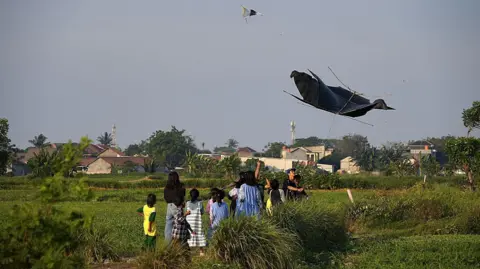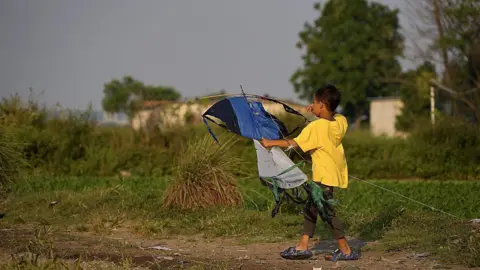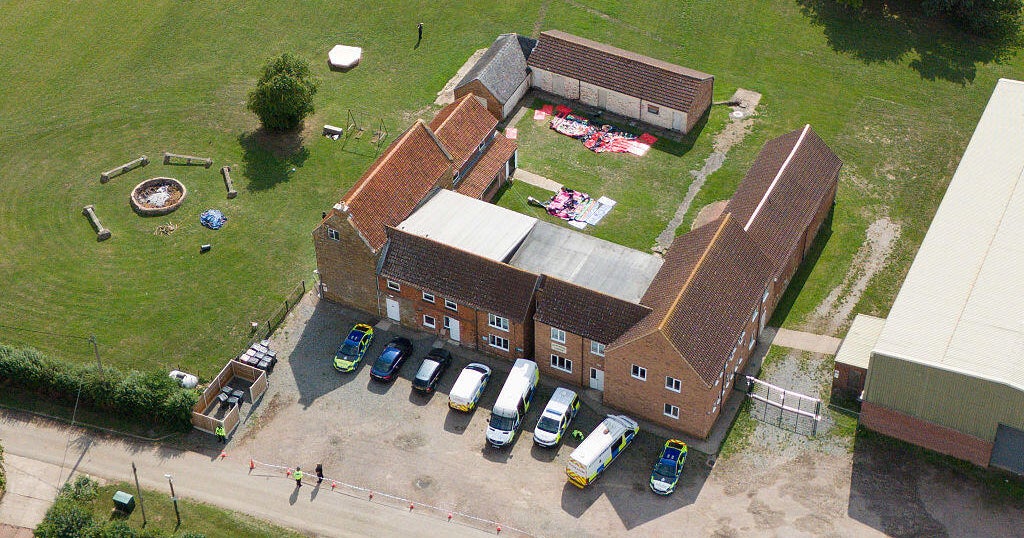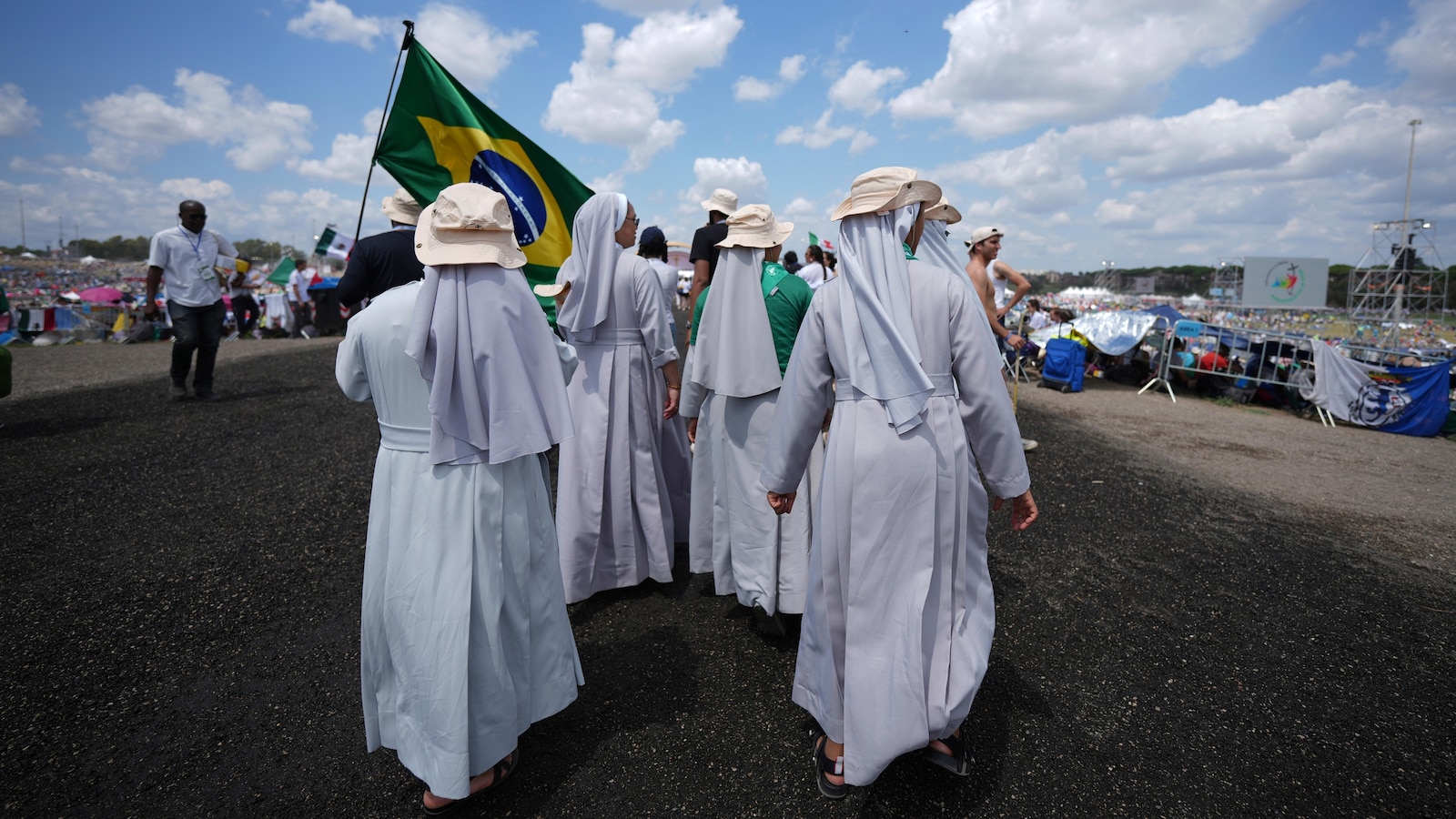Koh Ewe and Hanna Samosir
BBC News
Reporting fromSingapore and Jakarta
Watch: BBC visits field near Indonesian airport where children fly kites
At a paddy field two kilometres from Jakarta's international airport, the rustle of fluttering kites is periodically drowned out by the thunderous roar of plane engines.
Tugging at kite strings in the field are a group of children, their necks craned towards the skies. But their eyes are also darting below, keeping a lookout for patrolling airport officials who could come to confiscate their kites - and their fun.
"In the past, my friends and I would run away when an officer came," seven-year-old Atif, one of the kids in the field, tells the BBC. "Now I'm braver, so I go along with it when they scold me."
"If my kite is taken, it's sad, but I can always make another one."
A tug of war is unfolding here, between airport authorities and one of Indonesia's most cherished pastimes.
Kite-flying is popular in Indonesia - especially at this time of the year when students go on summer holidays. But authorities have issued warnings about the kites, which they say pose a safety hazard if they block aircraft sensors or get snagged in engines.
During three days in early July, kites disrupted 21 flights at Soekarno-Hatta International Airport, the one near the paddy field, according to air-traffic controller AirNav Indonesia. Some had been diverted to another airport and some aborted landings, deeming it too dangerous to go near the kites.
Kites are "moving obstacles" for planes and a "serious risk to flight safety", Putu Eka Cahyadi, head of the Soekarno-Hatta International Airport Authority, tells the BBC.
"We don't want accidents to occur."

 Haryo Bangun Wirawan/BBC
Haryo Bangun Wirawan/BBC
Children have continued to fly kites at a field near the airport, despite warnings from authorities
Such fears are not unfounded.
In July 2024, a helicopter crashed in Bali after it got entangled in kite strings, injuring three Indonesians and two Australians on board.
In July 2020, strings and bamboo sticks from a kite were found in the engine of a plane after it arrived at Soekarno-Hatta. While the plane had managed to land without mishap, the incident triggered serious safety concerns. The following month, the airport set up a task force to crack down on kite-flying near its premises.
Five years on, the problem has persisted. In July, transport minister Dudy Purwagandhi urged airport authorities and regional governments across Indonesia to minimise the harm that kites are posing to flights.
"It's certainly a fun activity, but we also need to educate them to prevent the public or children from engaging in activities that could endanger flights," says Mr Putu.
His colleagues have tried giving the kids footballs and badminton racquets to steer them towards other sports. But kite-flying is woven into the fabric of Indonesian culture.
Traditionally made with leaves, colourful paper or cloth, kites are flown in Indonesia for various purposes: for rice harvest ceremonies, to chase birds away from crops or, in Bali, as a form of prayer and offering to the gods.
"Kite flying has been passed down through generations from our ancestors. Almost every region in Indonesia has a tradition of kite flying," says Asep Irawan, an expert from the Indonesia Kite Museum.
"However, we need to be cautious, especially [with] children. They just fly them. They don't see the potential danger."

 Haryo Bangun Wirawan/BBC
Haryo Bangun Wirawan/BBC
Children say they can't find better places to fly their kites
Those caught flying kites, drones or other things that pose safety risks around airports may be jailed up to three years or fined one billion Indonesian rupiah ($61,000; £46,000).
But it's not just on airstrips that kites can be dangerous. In densely populated areas, kites are also a deadly distraction. Last year, an eight-year-old boy died after venturing onto a toll road in Depok city, south of Jakarta. Police believe he was hit by a car while chasing a kite.
In 2020, a man was arrested after his kite broke and fell onto a substation in Bali, causing hours of blackout in more than 70,000 houses and buildings.
Back on the paddy field near Soekarno-Hatta Airport, the children say they don't mean to mess with the planes - but they are hard-pressed to find better places for their hobby.
Jakarta lost 31% of its urban green spaces between 2000 and 2020, as fields and forests gave way to congested roads and apartment blocks.
"There's nowhere else around here," says Rasha, a 17-year-old who makes and sells kites. "There's one other spot, but it's still close to the airport. There just aren't any other places to fly."
The paddy field is now home to a community of kite enthusiasts, who organise regular kite-flying competitions. Rasha has won them twice.
He has got into trouble before with the patrolling airport officials, who chided him and confiscated his kites.
"The police even came to our house and took two of my kites and burned them, strings and all. After that, my siblings scolded me and told me to stop. But recently, I started flying kites again," he says.
"It is pretty dangerous. But once your kites have been taken away, you stop being afraid."

 15 hours ago
1
15 hours ago
1







![35-year-old American moved to Chengdu and lives on $30,000 a year: '[It's] poverty in America, but in China I'm living large'](https://image.cnbcfm.com/api/v1/image/108167583-1751548516689-chinacelia1.jpg?v=1751549197&w=1920&h=1080)


 English (US) ·
English (US) ·